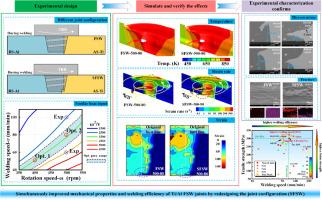新型阶梯结构Ti/Al异种合金搅拌摩擦焊接传热传质数值模拟
IF 5.8
2区 工程技术
Q1 ENGINEERING, MECHANICAL
International Journal of Heat and Mass Transfer
Pub Date : 2025-02-18
DOI:10.1016/j.ijheatmasstransfer.2025.126803
引用次数: 0
摘要
搅拌摩擦焊是钛/铝异种焊接中最合适的连接方法之一。了解和优化Ti/Al异种摩擦摩擦焊的传热传质行为对提高接头的力学性能至关重要。本文提出了一种新型的阶梯结构搅拌摩擦焊(SFSW),以优化传热传质,同时提高力学性能和焊接效率。采用CFD和VOF相结合的方法,建立了Ti/Al异种合金SFSW的多相数值模型。通过数值模拟和实验分析,揭示了新型阶梯结构对焊缝传热传质的影响机理,以及由此产生的焊缝根部组织。阶梯式结构使焊缝根部温度升高约17k,显著改善了焊缝根部的传热传质行为。SFSW方法显著提高了温度和应变速率,促进了Ti/Al界面的冶金结合。结果表明,阶梯式结构引起的温升并不局限于某一特定区域,而是整个阶梯式结构作为一个整体经历温升。阶梯式结构在不改变IMCs分布的情况下支持Al的粘附。通过将焊接速度从50 mm/min提高到80 mm/min, SFSW的焊接效率提高了60%,其极限抗拉强度达到320.4 MPa,比传统的FSW提高了18.4%。总之,阶梯式结构在促进冶金结合和优化传热传质方面至关重要。本文章由计算机程序翻译,如有差异,请以英文原文为准。

Numerical simulation of heat and mass transfer in novel stepped structure friction stir welding of Ti/Al dissimilar alloys
Friction stir welding (FSW) is one of the most suitable joining methods for Ti/Al dissimilar welding. Understanding and optimizing the heat and mass transfer behavior of Ti/Al dissimilar FSW is crucial for enhancing the mechanical properties of the joints. In this work, a novel stepped structure friction stir welding (SFSW) was proposed to optimize heat and mass transfer for simultaneously improving mechanical properties and welding efficiency. A validated multi-phase numerical model for SFSW of Ti/Al dissimilar alloy was developed using CFD in cooperation with the VOF method. Through numerical modelling and experimental analysis, the influence mechanism of the novel stepped structure on the heat and mass transfer, as well as the resulting microstructure at the weld root was revealed. The stepped structure leads to an increase in temperature at the weld root by approximately 17 K, significantly improving the heat and mass transfer behavior at the weld root. The SFSW approach significantly raises the temperature and strain rate, promoting metallurgical bonding in the Ti/Al interface. It is concluded that the temperature rise caused by the stepped structure is not limited to a specific region, but rather the entire stepped structure as a whole experiences the temperature increase. The stepped structure supports Al adhesion without altering IMCs distribution. By increasing welding speed from 50 to 80 mm/min, SFSW achieves a 60 % boost in welding efficiency, with ultimate tensile strength reaching 320.4 MPa, an 18.4 % improvement over conventional FSW. In summary, the stepped structure is crucial in promoting metallurgical bonding and optimizing heat and mass transfer.
求助全文
通过发布文献求助,成功后即可免费获取论文全文。
去求助
来源期刊
CiteScore
10.30
自引率
13.50%
发文量
1319
审稿时长
41 days
期刊介绍:
International Journal of Heat and Mass Transfer is the vehicle for the exchange of basic ideas in heat and mass transfer between research workers and engineers throughout the world. It focuses on both analytical and experimental research, with an emphasis on contributions which increase the basic understanding of transfer processes and their application to engineering problems.
Topics include:
-New methods of measuring and/or correlating transport-property data
-Energy engineering
-Environmental applications of heat and/or mass transfer

 求助内容:
求助内容: 应助结果提醒方式:
应助结果提醒方式:


